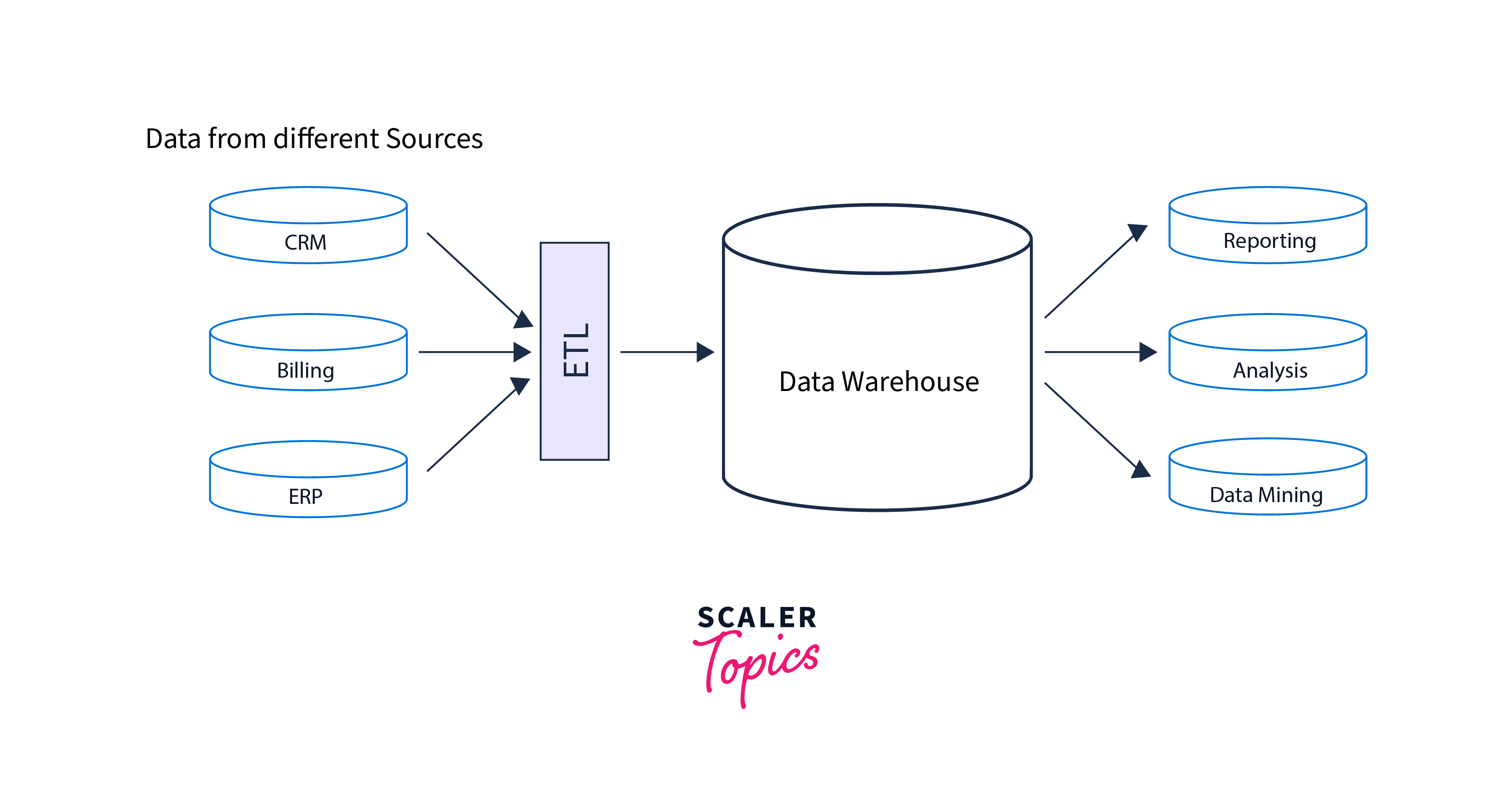Components of Data Warehouse
Overview
A data warehouse comprises ETL for data transformation, relational/columnar databases for storage, a user-friendly query interface via a semantic layer, and visualization tools for reports. Advanced systems also integrate data governance for accuracy and security, enabling organizations to collect valuable insights efficiently.
Source Data Component
Before learning about the components of a data warehouse, let us explore a few of the critical source data components.
Production Data
Real-time data from daily operations, including transactions, customer interactions, and metrics, aids in monitoring and identifying patterns to inform timely decisions for organizations.
Internal Data
Internal data from various divisions, including employment, financials, and reports, provides insights for strategy, resource allocation, and performance assessment, aiding in understanding company performance.
Archived Data
Archived data comprises historical records that are no longer actively used but are kept for compliance, legal, or analytical reasons. It assures regulatory compliance and allows for historical trend analysis.
External Data
External Data encompasses data from third-party providers, public databases, and industry studies, providing industry context for analysis, benchmarking, and trend spotting. Data governance ensures accuracy, consistency, and security throughout its life cycle.
Data Staging Component
Before learning about the components of a data warehouse, let's explore the data staging components.
The Data Staging Component includes three major stages: extraction, transformation, and loading.

Data Extraction
Data extraction is extracting information from multiple sources such as databases, APIs, or files. This stage ensures that pertinent and essential data is acquired for subsequent processing.
Data Transformation
Data Transformation takes place after Extraction. The extracted data is cleaned, formatted, and structured here to meet the needs of the destination system.
Data Loading
The final stage, Data Loading, involves transferring the converted data to the intended destination, typically a data warehouse or database. The data is organized to allow for simple querying and analysis.
Data Storage Components
One of the most important components of a data warehouse is the data storage components.
- Data storage relies on essential components for effective data maintenance and retrieval.
- Hard disc drives (HDDs) employ spinning platters and read/write heads for magnetic data storage.
- Solid-state drives (SSDs) utilize flash memory, ensuring faster data access compared to HDDs.
- Tape drives offer a cost-effective solution for long-term data storage needs.
- Storage Area Networks (SANs) and Network-Attached Storage (NAS) provide scalable options for centralized data management.
- Cloud storage utilizes remote servers to offer users flexible and accessible data storage solutions.
Information Delivery Component
The Information Delivery Component is a pivotal element in data systems, responsible for efficiently conveying processed data to users. Serving as the final stage of the data processing pipeline, it transforms raw data into understandable insights through tasks like structuring, visualization, and distribution, bridging the gap effectively.
Metadata Component
Metadata elements give critical information about other data, assisting in its effective organization, location, and interpretation. Tags, descriptors, and attributes are like labels that describe the characteristics of the main data, like files or entries in a database.
In databases, metadata components offer details about how tables are set up, how data is connected, and what types of data are stored. Properly managed metadata improves data integrity, searchability, and interoperability between systems.
Data Marts
Data Marts are focused data repositories for distinct business units, derived from diverse sources and stored as subsets of data warehouses. They enhance analysis speed with pre-aggregated, readily accessible data, aiding agile decision-making and subject-specific comprehension.
Management and Control Component
The Management and Control Component orchestrate several activities to provide smooth coordination and optimal functionality. This component oversees resource allocation, task scheduling, and subsystem communication. Administrators control setups, authorizations, and performance monitoring via a user-friendly interface.
Why do We Need a Separate Data Warehouse?
- Distinct Data Warehouse for Varied Demands:
A dedicated Data Warehouse is crucial due to diverse data processing needs. Unlike operational databases for transactions, it excels in advanced analytics and reporting. - Efficient Data Storage and Analysis:
Serving as a centralized repository for historical and varied data, a Data Warehouse streamlines search and analysis. Segregating operational and analytical tasks enhances performance while maintaining accurate insights. - Enhanced Decision-Making through Specialization:
Specialized Data Warehouses offer organized, high-performance environments optimized for profound data analysis and strategic business insights, improving decision-making capabilities.
Difference between Database and Data Warehouse
Let us now look at the difference between a Database and a Data Warehouse in more detail.
| Aspect | Database | Data Warehouse |
|---|---|---|
| Performance | Optimized for transactional tasks | Optimized for complex queries and analytical tasks |
| Query Complexity | Handles simpler queries | Supports complex analytical queries |
| Data Aggregation | Limited aggregation capabilities | Supports extensive data aggregation and summarization |
| Data Transformation | Minimal transformation beyond normalization | Often involves data cleansing and transformation |
| Data Volume | Manages moderate data volumes | Handles large volumes of data |
| Data Latency | Low latency for real-time operations | Tolerates higher latency for analytical processing |
| Data Granularity | Detailed and fine-grained data | Aggregated and summarized data for analysis |
Conclusion
- Databases provide organized storage for transactional data, whereas data warehouses store historical and aggregated data for analysis.
- Normalised schemas are used in databases for efficient storage and retrieval, whereas denormalized schemas are used in data warehouses to optimize query performance.
- Databases enable typical SQL queries for operational questions, but data warehouses support complicated analytical queries.
- For exact data representation, databases emphasize the Entity-Relationship model, whereas data warehouses use star or snowflake schemas for multidimensional analysis.
